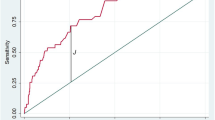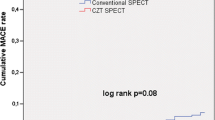Abstract
Background
Although the prognostic value of myocardial perfusion imaging using gated single photon emission computed tomography (SPECT) for predicting major cardiac events has been evaluated, little is known about the relevance of this procedure to the Japanese population.
Methods
A total of 4,031 consecutive Japanese patients with suspected or confirmed ischemic heart diseases were registered at 117 hospitals in the Japanese Assessment of Cardiac Events and Survival Study by Quantitative Gated SPECT investigation. Gated stress/rest myocardial perfusion SPECT was performed and the patients were followed up for 3 years. Segmental perfusion scores and quantitative gated SPECT results were calculated. Major cardiac events were defined as cardiac death, nonfatal myocardial infarction, and severe heart failure.
Results
During the 3-year follow-up, cardiac death (n = 57) and nonfatal myocardial infarction (n = 39) occurred in 96 patients (2.4%/3 years) when hard events were the endpoints. When severe heart failure was included as an endpoint, major cardiac events that developed in 175 patients (4.3%/3 years) comprised cardiac death (n = 45), nonfatal myocardial infarction (n = 37), and severe heart failure (n = 93). Normal and severely abnormal summed stress score values were associated with low (2.31%/3 years) and high (9.21%/3 years) rates of major cardiac events, respectively. Rates of major cardiac events were significantly higher in patients with ejection fraction (EF) <45% than in those with EF 45% or higher (16.55 vs 2.94%/3 years; P < 0.001). The incidence of major cardiac events within 3 years was also significantly higher among patients with high end-systolic volumes. The major event rates were similar among nondiabetic patients with and diabetic patients without prior myocardial infarction at 5.06% and 5.73%/3 years, respectively.
Conclusion
Cardiac event rates were significantly lower in the Japanese than in the USA and European populations. However, large myocardial perfusion defects and decreased cardiac function, as well as diabetes mellitus, could be predictors of high event rates and, thus, beneficial for risk stratification of Japanese patients with ischemic heart diseases.







Similar content being viewed by others
References
Klocke FJ, Baird MG, Lorell BH, Bateman TM, Messer JV, Berman DS, et al. ACC/AHA/ASNC guidelines for the clinical use of cardiac radionuclide imaging-executive summary: a report of the American College of Cardiology/American Heart Association Task Force on Practice Guidelines (ACC/AHA/ASNC Committee to Revise the 1995 Guidelines for the Clinical Use of Cardiac Radionuclide Imaging). Circulation 2003;108:1404–18.
Tamaki N. Guidelines for clinical use of cardiac nuclear medicine (JCS 2005). Circ J 2005;69 Suppl IV:1125–202.
Nakamura Y, Moss AJ, Brown MW, Kinoshita M, Kawai C. Ethnicity and long-term outcome after an acute coronary event. Multicenter myocardial ischemia research group. Am Heart J 1999;138:500–6.
Saito M, Fukami K, Hiramori K, Haze K, Sumiyoshi T, Kasagi H, et al. Long-term prognosis of patients with acute myocardial infarction: is mortality and morbidity as low as the incidence of ischemic heart disease in Japan. Am Heart J 1987;113:891–7.
Kawano H, Soejima H, Kojima S, Kitagawa A, Ogawa H. Sex differences of risk factors for acute myocardial infarction in Japanese patients. Circ J 2006;70:513–7.
Kusuoka H, Nishimura S, Yamashina A, Nakajima K, Nishimura T. Surveillance study for creating the national clinical database related to ECG-gated myocardial perfusion SPECT of ischemic heart disease: J-ACCESS study design. Ann Nucl Med 2006;20:195–202.
Sharir T, Germano G, Kavanagh PB, Lai S, Cohen I, Lewin HC, et al. Incremental prognostic value of post-stress left ventricular ejection fraction and volume by gated myocardial perfusion single photon emission computed tomography. Circulation 1999;100:1035–42.
Nakajima K, Kusuoka H, Nishimura S, Yamashina A, Nishimura T. Normal limits of ejection fraction and volumes determined by gated SPECT in clinically normal patients without cardiac events: a study based on the J-ACCESS database. Eur J Nucl Med Mol Imaging 2007;34:1088–96.
Germano G, Kiat H, Kavanagh PB, Moriel M, Mazzanti M, Su HT, et al. Automatic quantification of ejection fraction from gated myocardial perfusion SPECT. J Nucl Med 1995;36:2138–47.
Nakajima K, Nishimura T. Inter-institution preference-based variability of ejection fraction and volumes using quantitative gated SPECT with 99mTc-tetrofosmin: a multicentre study involving 106 hospitals. Eur J Nucl Med Mol Imaging 2006;33:127–33.
Hachamovitch R, Berman DS, Shaw LJ, Kiat H, Cohen I, Cabico JA, et al. Incremental prognostic value of myocardial perfusion single photon emission computed tomography for the prediction of cardiac death: differential stratification for risk of cardiac death and myocardial infarction. Circulation 1998;97:535–43.
Berman DS, Abidov A, Kang X, Hayes SW, Friedman JD, Sciammarella MG, et al. Prognostic validation of a 17-segment score derived from a 20-segment score for myocardial perfusion SPECT interpretation. J Nucl Cardiol 2004;11:414–23.
Sharir T, Kang X, Germano G, Bax JJ, Shaw LJ, Gransar H, et al. Prognostic value of poststress left ventricular volume and ejection fraction by gated myocardial perfusion SPECT in women and men: gender-related differences in normal limits and outcomes. J Nucl Cardiol 2006;13:495–506.
Berman DS, Kang X, Hayes SW, Friedman JD, Cohen I, Abidov A, et al. Adenosine myocardial perfusion single-photon emission computed tomography in women compared with men. Impact of diabetes mellitus on incremental prognostic value and effect on patient management. J Am Coll Cardiol 2003;41:1125–33.
Haffner SM, Lehto S, Ronnemaa T, Pyorala K, Laakso M. Mortality from coronary heart disease in subjects with type 2 diabetes and in nondiabetic subjects with and without prior myocardial infarction. N Engl J Med 1998;339:229–34.
Sone H, Katagiri A, Ishibashi S, Abe R, Saito Y, Murase T, et al. Effects of lifestyle modifications on patients with type 2 diabetes: the Japan Diabetes Complications Study (JDCS) study design, baseline analysis and three year-interim report. Horm Metab Res 2002;34:509–15.
Davis TM, Cull CA, Holman RR. Relationship between ethnicity and glycemic control, lipid profiles, and blood pressure during the first 9 years of type 2 diabetes: U.K. Prospective Diabetes Study (UKPDS 55). Diabetes Care 2001;24:1167–74.
Wackers FJ, Young LH, Inzucchi SE, Chyun DA, Davey JA, Barrett EJ, et al. Detection of silent myocardial ischemia in asymptomatic diabetic subjects: the DIAD study. Diabetes Care 2004;27:1954–61.
Shaw LJ, Berman DS, Hendel RC, Alazraki N, Krawczynska E, Borges-Neto S, et al. Cardiovascular disease risk stratification with stress single-photon emission computed tomography technetium-99m tetrofosmin imaging in patients with the metabolic syndrome and diabetes mellitus. Am J Cardiol 2006;97:1538–44.
Cerqueira MD, Weissman NJ, Dilsizian V, Jacobs AK, Kaul S, Laskey WK, et al. Standardized myocardial segmentation and nomenclature for tomographic imaging of the heart: a statement for healthcare professionals from the Cardiac Imaging Committee of the Council on Clinical Cardiology of the American Heart Association. Circulation 2002;105:539–42.
Acknowledgements
We thank the many physicians and technologists at all of the participating hospitals in the J-ACCESS study for their cooperation. A list of participating institutions and physicians appears elsewhere [6]. We also thank the staff of the J-ACCESS office for performing this study, which was supported by grants from the Japan Cardiovascular Research Foundation.
Author information
Authors and Affiliations
Corresponding author
Additional information
Financial support: Japan Cardiovascular Research Foundation
An erratum to this article can be found at http://dx.doi.org/10.1007/s00259-008-0881-3
Rights and permissions
About this article
Cite this article
Nishimura, T., Nakajima, K., Kusuoka, H. et al. Prognostic study of risk stratification among Japanese patients with ischemic heart disease using gated myocardial perfusion SPECT: J-ACCESS study. Eur J Nucl Med Mol Imaging 35, 319–328 (2008). https://doi.org/10.1007/s00259-007-0608-x
Received:
Accepted:
Published:
Issue Date:
DOI: https://doi.org/10.1007/s00259-007-0608-x




